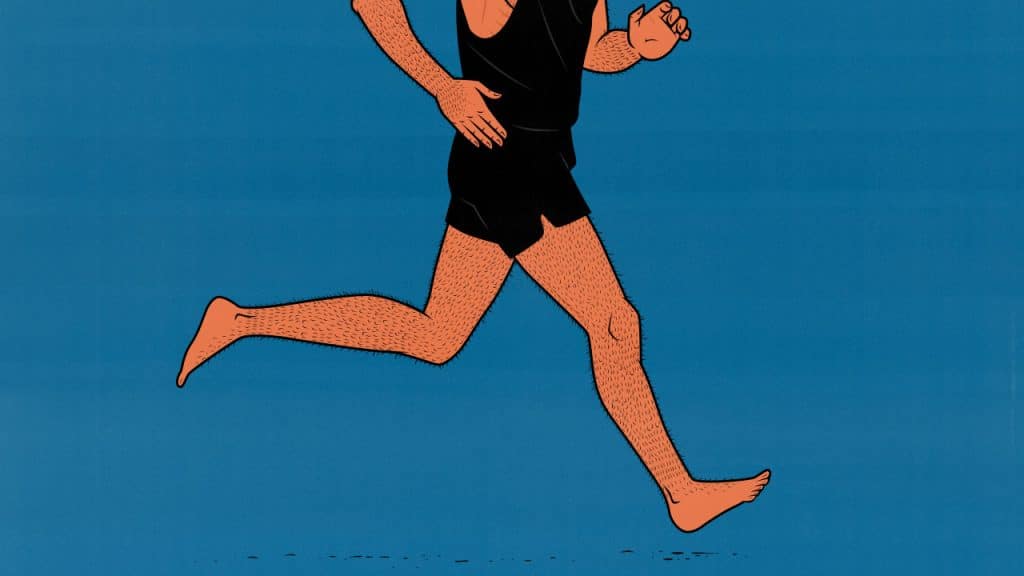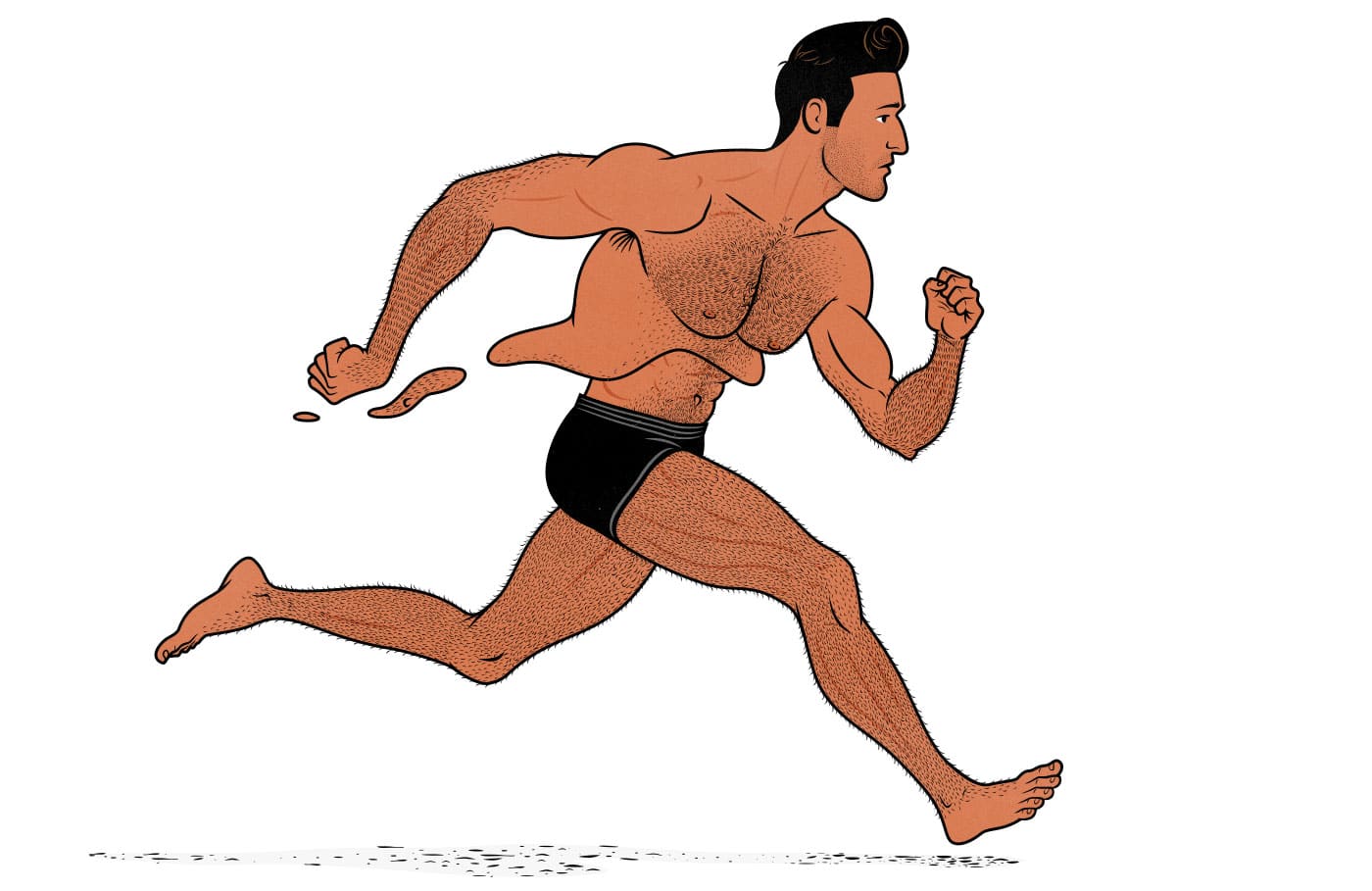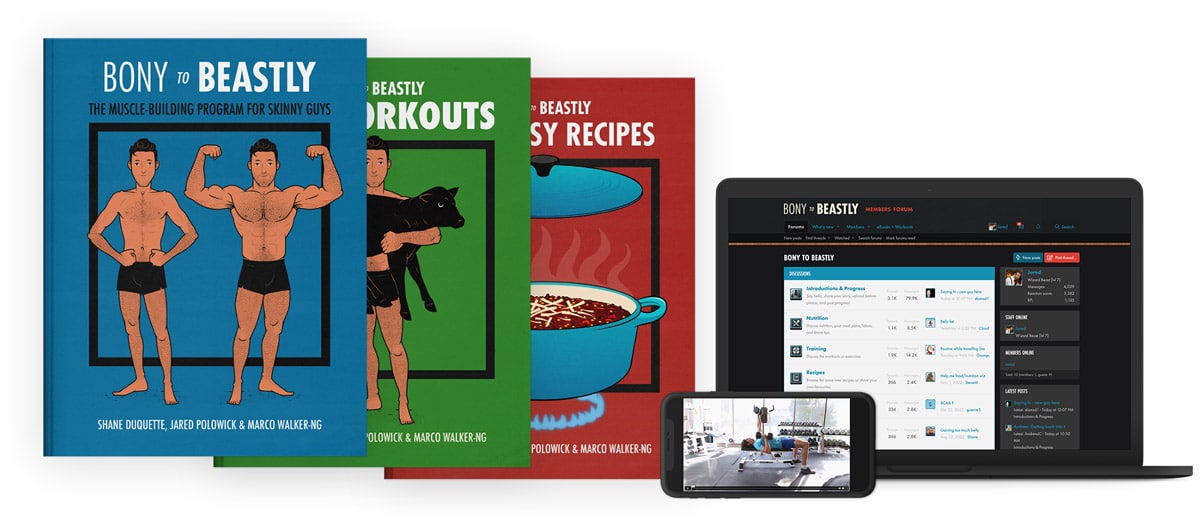
Should You Do Cardio While Bulking? Yes, Sort Of
Hypertrophy training is designed to stimulate muscle growth. You adapt by growing bigger, stronger muscles, but it won’t improve your cardiorespiratory health very much.
Cardio makes you fitter. You adapt to draw more blood into your heart, build more blood vessels, and produce more energy in your mitochondria. It’s great for you, but it won’t make you bigger or stronger.
Thus, a balanced workout routine includes both.
Here’s the problem: Doing both hypertrophy training and cardio at the same time causes us to adapt in two complementary but competing ways. You only have so much energy, only so many resources, so you can’t maximize every adaptation all at once. This is called the interference effect.
On the other hand, if cardio makes you fitter, you’ll be able to handle tougher hypertrophy training workouts. If it improves blood flow to your muscles, you’ll have improved performance and better recovery. There are muscle-building advantages to doing cardio, too.
Things get even more confusing if you’re a naturally thin “ectomorph” or “hardgainer.” The more cardio you do, the more calories you’ll burn and the more food you’ll need to eat. If you’re already struggling to eat enough to gain weight, that can be a problem.

The Many Benefits of Cardio
Cardio stands for cardiorespiratory training, where the goal is to elevate your heart rate to improve cardiorespiratory fitness adaptations. It’s a catch-all term for activities designed to strengthen your heart and lungs—brisk walking, rucking, jogging, cycling, rowing, aerobics, HIIT, and so on.
Cardio is an important part of a healthy exercise routine. The benefits are robust and plentiful, whether you’re skinny or not (study):
Cardio burns calories and helps people lose weight.- It makes our hearts bigger and more efficient.
- It increases our lung capacity.
- It reduces the risk of heart disease.
- It improves mood and reduces anxiety.
- It makes people look and feel more youthful.
- It improves sleep.
- It increases energy levels.
But as healthy as cardio is, it won’t help you get bigger or stronger. For that, you need hypertrophy training. You probably already knew that. So, let’s assume you’re considering doing cardio in addition to hypertrophy training—concurrent training.
Should Skinny Guys Do Cardio While Bulking?
If you can, you should do cardio while bulking. Cardio provokes different adaptations from hypertrophy training, and both sorts of adaptations are important.
For example, a meta-analysis by Momma and colleagues found that weight training reduced all-cause mortality by 15%. When cardio was added in, all-cause mortality dropped by 40% (reference). By doing both, you can add the better part of a decade to your lifespan.
But you don’t need to improve every aspect of your lifestyle all at once. If you’re new to exercise and your main goal is to build muscle, you could start by spending a few months bulking up, focusing on gaining 20–30 pounds of muscle.
When you finish your bulk, you can ease back on lifting and start listening to your appetite again. You don’t need a calorie surplus to make cardio adaptations, so that might be a great goal to fight for when you’re ready to take a break from overeating.
In the meantime, going on a 20-minute walk every day is more than enough to keep you healthy, especially if you’re new to it. That’s what I did during my first two bulks, while gaining my first 40 pounds of muscle.
Lifting Can Count as Cardio (Sort Of)
A 2014 study published in the Journal of Exercise Science (study) evaluated a bodybuilding workout by cardio standards. They measured the heart rate of sixteen people while doing a typical bulking workout. They were doing bench presses, lat pulldowns, bicep curls, leg presses, and so on. They did three sets of ten reps for each exercise.
The researchers found that the participants had the ideal heart rate for improving cardiovascular fitness for about half of the time they were weight training. Their cardiovascular fitness wasn’t the limiting factor, so it isn’t perfectly ideal, but it’s quite a lot better than nothing. If you’re out of shape, lifting can improve your fitness, at least during your first few months.
On the other hand, you need to brace your muscles while lifting weights. That tension keeps your heart and blood vessels contracted, raising blood pressure. To provoke cardio adaptations, you want your heart to expand to draw in more blood and your blood vessels to dilate to carry that blood to the muscles you’re working. So, to get proper cardio adaptations, you should add an activity like brisk walking.
How to Lift for Cardiorespiratory Health
If you wanted even greater cardiovascular benefits, you could structure your bulking workouts to keep your heart rate higher for longer. One way to do that is to be strict with your rest times. You can take that even further by doing supersets.
To build muscle properly, it helps to give your muscles enough rest between sets. However, while one muscle rests, you can train a different muscle group. For example, you can do a set of squats, rest a minute, then do a set of chin-ups, rest another minute, and then return to your squats. That’s a superset.
To be clear, even dense workouts are still designed for muscle growth, not for improving cardio. Bulking workouts won’t ever rival a dedicated cardio routine, but they’re a step in the right direction. Add a 20-minute daily walk to that, and you can take quite a few steps in the right direction.
Can Cardio Make it Harder to Gain Weight?
Doing cardio while bulking can make it harder to gain weight. Cardio burns a tremendous amount of calories per hour. I burned over a thousand calories running ten kilometres this morning. And unfortunately, your appetite might not increase by a proportionate amount (study, study). So, if you burn a thousand calories while jogging, you might only want to eat back 700, throwing you into a calorie deficit.
It’s not quite as bad as it sounds. Going on walks can speed up and smooth out digestion. If you’re feeling sluggish after a big meal, you can often walk it off. In that sense, bulking and cardio fit together quite well. It all depends on how intense your cardio is, how much of it you’re doing, and how good you are at eating a big bulking diet.
Does Cardio Interfere With Muscle Growth?
Cardio can interfere with muscle growth, but only under some circumstances. Even if you can manage to eat enough calories to gain weight, you can run into something called the interference effect, where the cardio stimulus competes with the muscle-building stimulus.

If you do your cardio and hypertrophy training as part of the same workout, the interference effect can cut your rate of muscle growth in half (study). However, there’s a simple solution. All you need to do is separate your cardio and lifting sessions by at least 6 hours, and ideally by a full day (study).
Does Cardio Improve Muscle Growth?
One of the benefits of cardio is improved blood flow to your muscles, allowing you to deliver energy to them. For example, if you go jogging, your body will adapt to deliver more blood to your leg muscles, allowing you to jog faster for longer. This improved blood flow supports muscle growth. So, it could be that as you get fitter, you’ll have an easier time building muscle (study).
To get these benefits, you don’t need to do cardio while bulking. You could also bulk and then do cardio, or do cardio and then bulk. You could also incorporate high-rep sets into your bulking routine.
The cardio adaptations are muscle-specific, so if you wanted to improve blood flow to your biceps, you wouldn’t go jogging; you’d go rowing or do high-rep sets of bicep curls. Doing sets of 20–40 reps should be heavy enough to stimulate muscle growth while also being light enough to improve blood flow.
Does Cardio Ward Off Fat Gain?
Doing cardio could conceivably make your gains leaner. There’s an idea called energy flux (G-Flux). Ryan Andrews, RD, and John Berardi, PhD, are famous for writing about it over on Precision Nutrition. We’ve written about it in our article for skinny-fat guys, too.

The idea is that the more calories you burn, the more calories you’ll need to eat. Eating more food means eating more vitamins, minerals, probiotics, fibre, and phytonutrients. And since your overall food volume is higher, you won’t need to worry as much about making every calorie count.
Conclusion
For general health, do 150+ minutes of cardio and 2+ hypertrophy training workouts per week. If you’re new to cardio, you can start by going on a brisk 20-minute walk every morning. That won’t be enough forever, but it’s more than enough for now.
If you’re bulking and doing cardio, make sure to prioritize your priority. If your main goal is to stimulate muscle growth, invest your best energy into training for muscle growth. Do your cardio on your rest days, and keep it easy enough that it helps you feel energized the next day, not beat up and tired. There will be plenty of time to get beat up by cardio after you finish bulking.

If you want us to walk you through the entire bulking process, check out our Bony to Beastly (men’s) program or Bony to Bombshell (women’s) program. They include a 5-month customizable workout routine, a full bulking diet plan, a bulking recipe book, a deep dive into lifestyle and fitness, and coaching from us.

